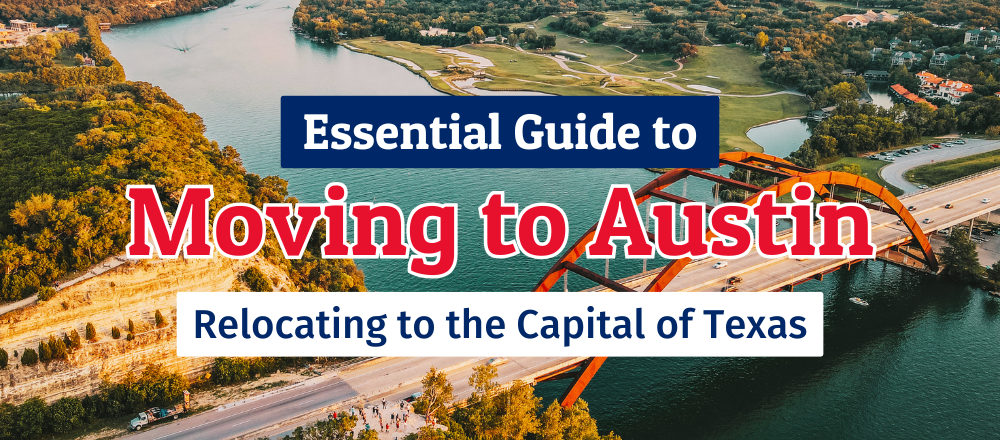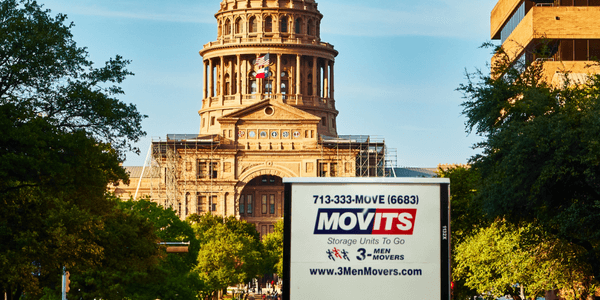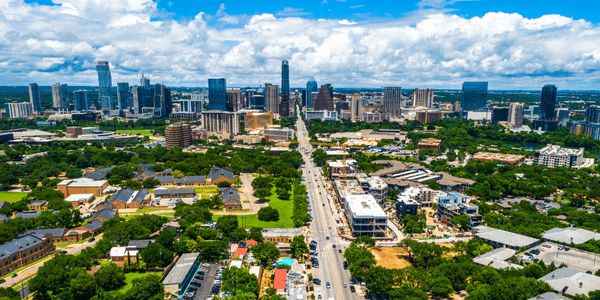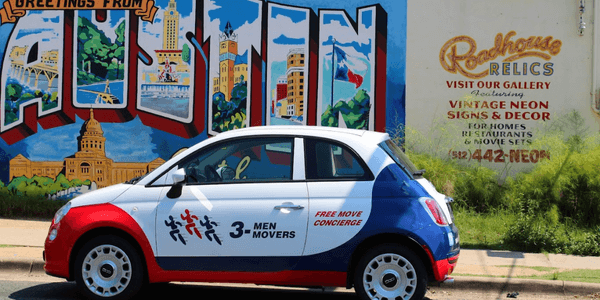

Introduction to Austin, Texas
Austin, the capital of Texas, is also known as the "Live Music Capital of the world," with a unique blend of arts, government, and small-town culture all contributing to its battle cry of "Keep Austin Weird." The thriving central Texas city offers a hot, dry climate, world-class BBQ and Mexican cuisine, and much to do, whether it be outdoor activities or the music scene. It's home to high rises, the University of Texas, as well as Dell Computers.
Suppose you're considering moving to or in the process of moving to Austin. In that case, there are some key things to know about the city and its surrounding suburbs, as well as the resources available to new residents and those considering the move.
Austin Demographics
As of 2024, Austin's population is just shy of one million residents, with a median household income of $91,500. The politics of Austin are much more liberal than much of Texas, and the population makeup is roughly 47% white, 33% Hispanic, and 8% each for Asian and Black communities. The median age of Austin is relatively young (34-35 years old) due to millennials and Gen-Zers moving to the area for jobs and opportunities.
Location and Climate in Central Texas
Austin, Texas, is situated in the heart of Central Texas and is characterized by a hot and dry climate, with summer highs averaging around 95°F and mild winters that rarely drop below 40°F. The Colorado River runs through Austin, providing a beautiful backdrop to the city's vibrant culture and entertainment scene, with numerous parks and outdoor spaces to explore. Austin's climate is ideal for outdoor activities, with plenty of sunshine and warm weather year-round, making it a perfect location for festivals and events.
The city's location in Central Texas also makes it an ideal base for exploring the surrounding countryside and nearby towns, offering numerous opportunities for day trips and weekend getaways.

Why So Many People Move to Austin
With its unique blend of high-tech presence, government, and thriving arts and music scene, Austin is a natural draw for a diverse range of individuals. If you're planning a relocation, it's helpful to connect with trusted Austin movers who know the neighborhoods and logistics inside out.
Job Market
The city's robust job market, offering numerous opportunities in the tech industry, makes it an attractive destination for professionals and entrepreneurs, characterized by a high quality of life and a diverse range of amenities.
Tech Sector
Austin has a significant tech presence and is home to the following tech giants:
-
Dell-headquartered in Austin
-
Apple maintains a large campus in Austin and continues to expand operations there
-
Oracle-A major provider of cloud services, ERP, and CRM software
-
Amazon-Has both a corporate office in addition to distribution centers in Austin
-
Tesla-Moved its headquarters to Austin in 2021
-
Maintains a strong presence in Austin, including a research laboratory
Other Major Employers
Austin isn't only home to tech giants but also many private sector and public sector employers, including:
-
Whole Foods Market-Headquartered in Austin
-
State government, as TX's capital
-
Music and arts management
Other Reasons People Are Moving to Austin
Austin's vibrant music scene, with numerous festivals and venues, is a major draw for music lovers, musicians, and music managers, with a wide range of genres and styles to choose from. From block to block down 6th Street, you can find a diverse mix of blues, country, rock, reggae, jazz, and other genres, all performed live and in a very lively atmosphere.
The city's outdoor recreational opportunities, including hiking, biking, and kayaking, make it an ideal destination for outdoor enthusiasts, with numerous parks and green spaces to explore.
Austin's friendly and welcoming community, with a strong sense of connection and belonging, makes it easy for newcomers to settle in and make friends, with a wide range of social and cultural events to attend.
Healthcare and Services
Austin has a well-developed healthcare system with strong presences from the following healthcare providers:
-
St. David's HealthCare- an HCA-affiliated hospital network
-
Ascension Seton- A Catholic non-profit network
-
Baylor Scott & White Health- Statewide non-profit network
-
UT Health Austin/Dell Med- Academic medical center, teaching hospital, and UT Health specialty clinics
-
Community Care/Central Health- A public, non-profit safety net network
These networks, in addition to a future planned MD Anderson Cancer Center that is set to break ground in 2026, mean that you have plenty of options for healthcare providers.
Cost of Living and Housing
Austin, like the entire state of Texas, has one significant cost of living benefit: the absence of a state income tax. The state of Texas has a sales tax of 6.25%, with municipal taxes varying by city. Austin city sales tax adds 1%, for a total of 7.25% sales tax. As for property owners, you can expect an effective property tax rate of 1.6% to 1.8%, depending upon county, school district, and special district taxes.
Housing Market
The Austin housing market has experienced increased activity recently, but from 2023 to 2025, it has seen modest growth and stabilizing housing prices. The influx of tech jobs over the past decade has led to a rise in prices, with the median price within city limits reaching $480,000 in 2024. However, the entire metro area, including the suburbs of Round Rock, Cedar Park, and Pflugerville, brings the median price down to around $445,000. In comparison to other Texas metro areas, the cost of housing is higher but still significantly lower than tech centers like San Francisco ($1.2 million median home price), making Austin an attractive area to relocate to.
Other Living Costs
Austin's cost of living is also influenced by the prices of groceries, labor, transportation, and other essentials; however, overall, it remains a relatively affordable city, offering a wide range of options for people of all budgets and lifestyles. Another cost in time is the traffic congestion within Austin, and while it takes some time to get used to, Austin is making improvements to alleviate traffic. On a brighter note, in many instances, it is cheaper to fly out of Austin-Bergstrom International Airport than many other airports in Houston and Dallas.

Where to Live In Austin
Austin and its surrounding suburbs offer a wide variety of lifestyle-rich neighborhoods that cater to the needs of almost everyone, from young singles to growing families; there's something for everyone. Here's a peek into each of Austin's metro areas and what they have to offer.
Downtown Austin
If you're looking for a modern urban setting, downtown is home to most of the tech hub, skyscrapers, and historic areas, such as 6th Street. Just across the Colorado River is Butler Metro Park, home of biking and walking trails, kayaking, and the Stevie Ray Vaughan statue. With easy access to work, play, and the historic Rainey Street district, downtown has something to offer for everyone. With median home prices reaching $749,000 as of May 2025, you'll pay more to be at the heart of the city, but the amenities are outstanding. From the West end of 6th Street to the East end of 6th Street is music central, and the reason why many consider it the "music capital of the world." It's known for its bars and clubs, with a wide variety of music genres. While Austin City Limits isn't on 6th, it's only a short walk or ride on West 2nd Avenue. Downtown is also home to the South by Southwest Film Festival, making the area an authentic entertainment Hub.
East Austin
Home to a diverse collection of cultures and ethnicities, East Austin boasts a wide variety of restaurants and activities, ranging from golf at Morris Williams Golf Course to indoor bouldering at the Bouldering Project Springdale. Its proximity to Lady Bird Lake hike and bike trail gives outdoor people something to look forward to. And, of course, for the BBQ fans, there's Franklin's Barbecue as you edge closer to downtown. And while you're still close to downtown, the median price of housing comes in at $595,000, so many people are willing to trade a little travel time to get more home for their money.
Central Austin
Home to the University of Texas, the state capital, and the Moody Center, Central Austin is considered a young and vibrant section of Austin. Of the 65,000+ households in the area, only 13% of the households have children, and only 33% of the households are family households. The average household income in Central Austin is $141,000 per year, and nearly 20% of the workforce is comprised of entrepreneurs. Over half the population is unmarried, so the area is skewed to young adult activities, restaurants, and lifestyle.
Bee Cave, Leander, Pflugerville, and Cedar Park
For people moving to the Austin area, some of the fastest-growing suburbs are located around the city itself. Bee Cave boasts an affluent hill country feel, with luxury homes, gated communities, and the highly rated Travis ISD. Its proximity to hiking trails, Lake Travis, and the Barton Creek Greenbelt offers something for most outdoor enthusiasts. The median price of home sales in the area as of May 2025 is $870,000, which may not be within everyone's budget.
For more affordable housing, Leander, Pflugerville, and Cedar Park offer median housing prices ranging from $395,000 to $501,000, but that doesn't mean these areas are lacking in amenities or strong communities. The Capital Metro Rail links Leander to downtown, features several top-rated schools within the Leander ISD, and offers parks and recreation, making it perfect for first-time buyers. Pflugerville is centrally located between Round Rock and Austin, with a 25-minute drive to downtown. It's the most affordable area, offering outdoor activities on Lake Pflugerville, and has a strong community vibe. Finally, Cedar Park is one of Austin's largest suburbs and is home to the H-E-B center, which hosts concerts, Texas Stars hockey, and family events. It is serviced by Leander ISD, so the schools are excellent, and the area is considered ideal for mid-career professionals.

Moving to Austin Resources
If you're getting ready to move to Austin, you'll need to find the utility providers and perhaps research the local schools. Here are some of the local resources that you'll need to investigate:
-
Utilities servicing Austin
-
Texas Gas Service - Austin natural gas supplier
-
Austin Energy - Austin Electric company
-
Austin Water - Austin's water utility site
-
Austin Resource Recovery -Trash collection, recycling
-
-
School districts - discover schools, enrollment, and calendars for your area
-
Travis ISD
-
Leander ISD
If your move to Austin is imminent, selecting a mover that services Austin locally or nationally will require some research.
Local movers that can perform moves to Austin from other Texas metro areas
-
3 Men Movers Austin (okay, shameless plug, as we can move you from Houston, SA, and Dallas metro areas to Austin or within Austin)
-
Two Men and a Truck
-
Move Buddha
National movers if you're moving from another state
-
Atlas Van Lines
-
PODS or 1-800-PackRat (if you're doing a DIY move)
-
Mayflower
Be sure to obtain multiple quotes and thoroughly understand what each moving company offers in terms of services, hourly rates, and any additional fees. Also, make sure to check their standing with the BBB, Google reviews, and the Texas DMV to ensure that they are licensed, insured, and trusted for their work.
If you've just completed a move to Austin, here are a couple of local places where you can recycle cardboard moving boxes:
-
Austin Recycling and Reuse Drop-Off Center - Free for Austin and Travis County residents, but an appointment is required.
-
Round Rock Recycling Center - Open 9:30 am-6 pm, Monday-Saturday. Accepts items from appliances to styrofoam, as well as the usual recyclables.
-
Go to loadup.com - they perform recycling pickup and junk removal.
Final Thoughts on Moving to Austin
Austin, Texas, is a beautiful and vibrant city with a thriving culture, diversified economy, and engaged community, making it an appealing destination for people from around the world. The city's tech job market, affordable cost of living, and high quality of life make it an ideal place to live, work, and play, offering numerous opportunities to discover new things and form connections. Austin's commitment to keeping Austin weird and vibrant, with a strong focus on community and connection, makes it a great place to call home, offering a wide range of amenities and services.